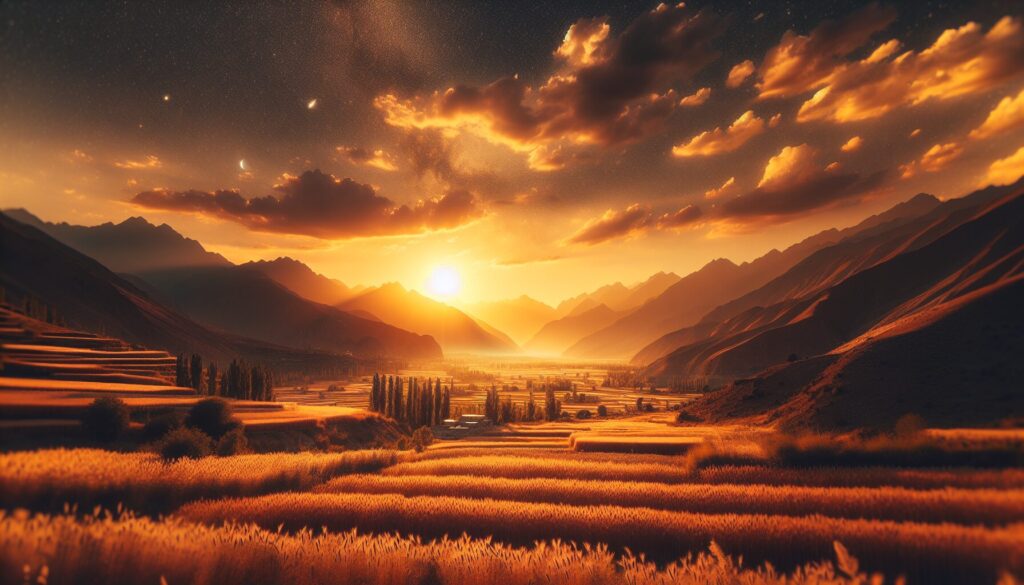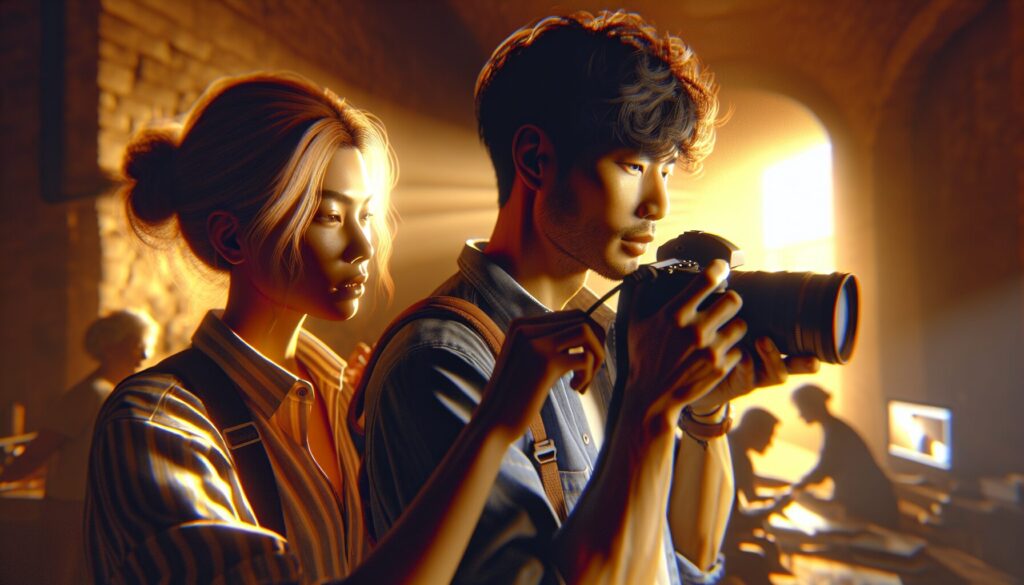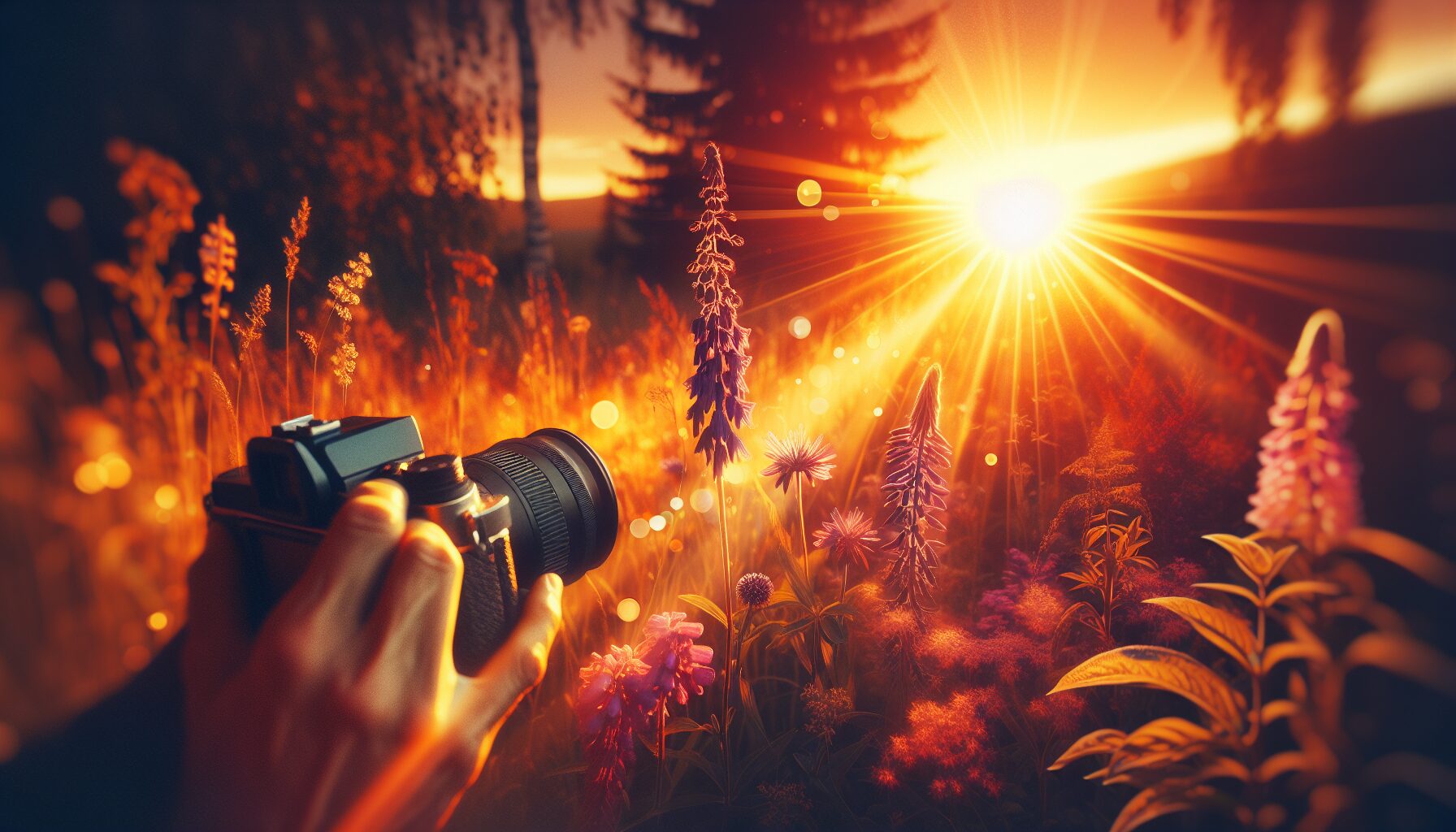Golden hour photography is like capturing magic with your camera! Ever experienced a sunset in Lahore or Karachi? The way the light paints everything in warm hues is simply mesmerizing. I remember my first golden hour shoot with my trusty Canon EOS R5. Armed with a 50mm f/1.8 lens, I set my ISO to 100, aperture to f/16, and shutter speed to 1/30s. The results? Pure art! During golden hour, the sun is low, casting a soft glow. It’s perfect for avoiding harsh shadows. Additionally, using a polarizing filter can enhance those colors beautifully. And if you’re in the northern regions like Gilgit-Baltistan, the golden light against the mountains is breathtaking. Whether you’re a beginner or a pro, exploring these techniques can elevate your photography game. Don’t forget to check out resources from National College of Arts or Pakistan Photographic Society for more inspiration.
Related: Natural Light Photography: A Deep Dive Into Techniques
Understanding the Science Behind Golden Hour
Golden hour, that magical time just after sunrise or before sunset, is adored by photographers for its soft and warm light. But what’s happening scientifically to create this perfect setting? Let’s dive in! During golden hour, the sun is low in the sky, which means its light travels through more of Earth’s atmosphere. This extra distance scatters the shorter blue and violet wavelengths, leaving behind the beautiful reds, oranges, and yellows we love.
I remember my first golden hour shoot in the serene valleys of Hunza. I was using my Canon EOS R5 with a 50mm f/1.8 lens. I set my camera to ISO 100, f/16, and a shutter speed of 1/30s. The results were stunning! The warm hues added depth to the landscape, making the mountains appear even more majestic. If you’re photographing in a place like Lahore, where the haze can add a unique texture to your photos, understanding this scattering effect is crucial.
The Role of the Atmosphere
Moreover, the angle of the sun affects shadows and highlights, adding texture to your images. This is particularly noticeable in architectural photography, where buildings in Karachi can take on an almost ethereal glow. To capture these effects, you might want to try a polarizing filter. It can help manage reflections and enhance colors. Additionally, be mindful of the changing light intensity. As the golden hour progresses, the light can quickly shift. Therefore, adjusting your camera settings on the fly is essential to keep up with these changes.
Finally, if you’re in the northern areas of Pakistan, like Skardu, the golden hour can be shorter due to the surrounding mountains. Timing your shots is crucial. Apps like The Photographer's Ephemeris can help you plan your shoot down to the minute. So, get out there and see how the science of light can elevate your photography.
Best Locations in Pakistan for Golden Hour Shots

Pakistan is an absolute gem for golden hour photography! One of my favorite spots has to be the breathtaking Hunza Valley. I remember heading there with my trusty Canon EOS R5, equipped with a 24-70mm f/2.8 lens. I set my ISO to 100, aperture to f/16, and a shutter speed of 1/30s to capture the vibrant hues as the sun dipped behind the majestic peaks. The valley’s serene atmosphere makes it perfect for capturing those soft, magical tones of the golden hour. Additionally, the Hunza River adds a reflective element that enhances the entire scene.
Another fantastic location is the mesmerizing Badshahi Mosque in Lahore. This architectural marvel offers a stunning backdrop, especially when the sun casts its warm glow on the ancient bricks. I once used a polarizing filter here to minimize glare and enhance colors. It brought out the mosque’s intricate details beautifully. The key here is to shoot from a low angle to include both the mosque and the colorful sky.
Exploring the Coastal Beauty of Karachi
For those near the coast, Karachi’s Clifton Beach provides a unique setting. The beach is perfect for capturing silhouettes against the setting sun. Using a 50mm f/1.8 lens, I aimed for a shallow depth of field, which beautifully isolated my subjects against the vibrant sky. Furthermore, a tripod is essential here to maintain stability as the light fades quickly. The Karachi skyline in the background adds an urban touch to your compositions.
According to a report by Dawn, Karachi’s coastline is a hub for photographers year-round. Moreover, don’t miss out on the stunning landscapes of Fairy Meadows in Gilgit-Baltistan. It’s a bit of a hike, but the view of Nanga Parbat during golden hour is worth every step. My advice is to use a wide-angle lens to capture the expansive beauty of the mountains. The shadows cast by the peaks create a dramatic effect that’s truly captivating.
Lastly, don’t overlook the Thar Desert. It offers a contrasting beauty with its golden dunes. During my visit, I used an 85mm lens to capture the soft curves of the sand. The warm tones of the desert landscape during the golden hour are unparalleled. Remember, the key is to experiment with different compositions and settings to truly capture the essence of each location. The diversity of Pakistan’s landscapes offers endless opportunities for stunning golden hour photography adventures.
Essential Equipment for Capturing Golden Hour
When it comes to capturing the mesmerizing hues of golden hour in Pakistan, having the right gear is key. Trust me, I’ve learned this from countless sunrise and sunset shoots along the stunning beaches of Karachi. First and foremost, a camera with excellent low-light performance is essential. The Canon EOS R5 is a fantastic choice, boasting superb image quality and a sensor that excels in various lighting conditions.
Of course, lenses play a crucial role too. A fast prime lens like the 50mm f/1.8 can work wonders during golden hour. It allows you to capture beautiful bokeh and isolate your subject against those dreamy backgrounds. Additionally, using a wide-angle lens, such as a 16-35mm f/2.8, lets you take in more of the breathtaking landscapes, especially when you’re in places like the northern areas or the Thar Desert.
Other Must-Have Accessories
Don’t overlook the importance of a tripod. During golden hour, light levels can drop quickly, and a sturdy tripod ensures you capture sharp images without camera shake. I remember shooting in Lahore’s historic streets and being grateful for my reliable Manfrotto tripod. A remote shutter release is also handy to avoid any motion blur when taking long exposures.
Filters can enhance your golden hour photography as well. A polarizing filter helps manage reflections and boosts color saturation. Meanwhile, a neutral density filter lets you play with longer exposures, creating those ethereal, silky water effects. For more insights on using natural light effectively, be sure to check out our piece on mastering natural light photography techniques.
Finally, always carry extra batteries and memory cards. Golden hour waits for no one, and you wouldn’t want to miss that perfect shot. With this gear, you’ll be well-equipped to capture the golden hues that make Pakistan’s landscapes truly magical. For further details on camera models and gear, you might want to check out resources from Nikon Pakistan and Canon Pakistan.
Techniques to Perfect Your Golden Hour Photos

Capturing those stunning golden hour shots is something every photographer in Pakistan dreams of. The light during this magical time is just perfect, but getting it right involves a few techniques. Let’s start with the camera settings. When I first ventured into golden hour photography, I used my trusty Canon EOS R5. It’s a fantastic camera for this kind of work. I paired it with a 50mm f/1.8 lens, which is superb for capturing that dreamy background blur. The settings I found most effective were ISO 100, f/16, and a shutter speed of 1/30s. These help in capturing the soft, warm glow without overexposing the image.
However, it’s not just about settings. Composition plays a crucial role too. I often head to the hills around Islamabad for those breathtaking landscapes. Positioning the sun behind your subject can create a beautiful halo effect. Additionally, consider using a polarizing filter to reduce glare and enhance the colors. I learned this trick from a workshop with Pakistan Photographers Guild, and it has made a world of difference.
Post-Processing Tips
Editing your photos can take them from good to great. I use Adobe Lightroom for post-processing. It allows you to enhance the golden tones and adjust shadows to highlight your subject. Furthermore, try adjusting the white balance to get that perfect warmth in your images. A little clarity boost can also make the details pop. Remember, the goal is to keep the natural feel, so avoid over-editing.
Finally, timing is everything. The golden hour in Pakistan varies depending on the time of year. Apps like The Photographer's Ephemeris are excellent for planning your shoots. They provide precise sunrise and sunset times, ensuring you don’t miss a moment. So grab your camera and explore the beautiful landscapes around you during this magical time.
Post-Processing Tips for Enhancing Golden Hour Images
Post-processing golden hour images can be such a delightful experience, especially when you’re working with those magical hues captured during sunrise or sunset. I remember one time I was out in Lahore with my trusty Canon EOS R5. The light was perfect, and I used a 50mm f/1.8 lens, setting my ISO to 100, f/16, and shutter speed to 1/30s to catch that dreamy glow. However, the real magic often happens in the editing room.
Start with adjusting the white balance to bring out those warm tones. In Adobe Lightroom, try moving the temperature slider towards the yellow side. It enhances the natural warmth of golden hour. A little tweak in the tint slider towards the magenta can also enrich the colors. Additionally, increasing vibrance can make those subtle oranges and pinks pop without oversaturating the image.
Advanced Techniques for Stunning Results
Another technique is using the tone curve to fine-tune the contrast. By creating a gentle S-curve, you can enhance the contrast, making the highlights shine while keeping the shadows deep. Furthermore, using the graduated filter tool in Lightroom can help balance the exposure, especially if the sky is too bright compared to the foreground.
Don’t forget about the details! Sharpening your image slightly will bring out textures, especially if you’re capturing cityscapes or landscapes. In Lahore, I love capturing the intricate designs of the Badshahi Mosque. The details pop beautifully after some careful sharpening. Lastly, always consider using noise reduction, particularly if you’ve shot at a higher ISO. It helps maintain a clean look, especially in the darker areas of your image.
For more in-depth tutorials, you might want to check out resources from `National College of Arts` or explore the workshops offered by `Photographers Society of Pakistan`. These can provide valuable insights and help hone your skills even further.
Conclusion
In essence, capturing the enchanting hues of golden hour photography in Pakistan is a delightful blend of art and science. The article highlights the importance of understanding light behavior, using appropriate gear like the Canon EOS R5, and mastering techniques to enhance your photography. From the stunning landscapes of Hunza to the architectural wonders of Lahore and the coastal beauty of Karachi, Pakistan offers numerous breathtaking locations for golden hour shoots. Essential equipment, such as prime lenses and tripods, combined with post-processing skills in software like Adobe Lightroom, can elevate your images to new heights. Whether you’re a seasoned photographer or a beginner, experimenting with these techniques and exploring the diverse landscapes will undoubtedly enhance your golden hour photography. So, grab your camera and embrace the magic of golden hour in Pakistan. Happy shooting!
Continue Exploring
Unlock the secrets of capturing stunning images with just the power of natural light. Dive deep into techniques that will elevate your photography game to the next level.
Frequently Asked Questions
What are the best golden hour photography tips for capturing landscapes in Pakistan?
To capture stunning landscapes during the golden hour in Pakistan, find a location that offers an unobstructed view of the horizon. The diverse landscapes, from the mountains in the north to the deserts in the south, provide ample opportunities. Use a tripod to stabilize your camera for long exposures, and experiment with different angles to make the most of the warm, soft lighting. Remember to check the local sunrise and sunset times to plan your shoot accordingly.
How can I improve my portrait photography during the golden hour in Pakistan?
To enhance portrait photography during the golden hour in Pakistan, position your subject with the sun behind them to create a beautiful backlight effect that adds depth and warmth. Use a reflector to bounce light back onto your subject’s face and reduce harsh shadows. Golden hour is also perfect for experimenting with silhouettes against Pakistan’s iconic backdrops, like the Badshahi Mosque in Lahore or the Faisal Mosque in Islamabad.
What camera settings should I use for golden hour photography in Pakistan?
For golden hour photography in Pakistan, start with a low ISO setting to reduce noise and a wide aperture (e.g., f/2.8 or f/4) to create a shallow depth of field and capture more light. Adjust the shutter speed to balance exposure, keeping it fast enough to avoid motion blur if shooting handheld. Consider using manual mode to have full control over your camera settings, and experiment with different white balance settings to emphasize the warm tones characteristic of the golden hour.


Leave a Reply